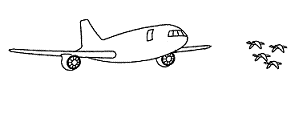Bird Strike Committee Proceedings

Bird Strike Committee-USA/Canada Joint Annual Meeting: 2nd (2000)
Date of this Version
August 2000
Document Type
Article
Abstract
On February 1, 2000, Dover Air Force Base became the first Air Force base in the world to employ a Border Collie in its airfield wildlife management program. Initial results from Border Collie Rescue’s program at Dover AFB are tremendously encouraging, as a substantial percentage of large birds has been excluded from the airbase and the surrounding farmlands, an overall area encompassing roughly 46 km2. Total bird numbers were reduced by more than 150,000 birds (99.1%) within a short initial 4-week period. The reduction in bird populations present in the Dover AFB environment was accomplished while the numbers of snow geese in the surrounding area had increased significantly in the same time frame. Figures from bird surveys by the Delaware Department of Natural Resources showed the number of snow geese in Delaware during the same month of February increased by more than 50.5% while the number of snow geese in the wildlife area nearest to the airbase (Bombay Hook) increased by more than 310%. This demonstrates that the birds had simply vacated the area immediately surrounding the airbase but remained in Delaware in increasing numbers. Pilots have noted large numbers of birds congregating just outside the Border Collie-patrolled “zone” and field surveys have verified these observations. All of this was accomplished with one wildlife officer, a single Border Collie, and a vehicle. Though the long-term effect on the migratory populations of birds at Dover AFB remains to be seen, the initial results suggest a highly effective mechanism for Dover AFB to combat its bird strike problem.

